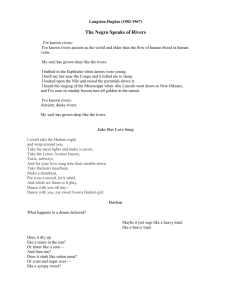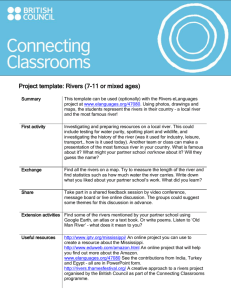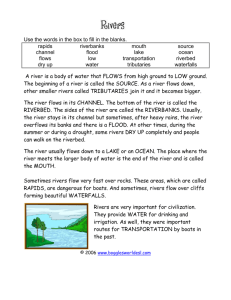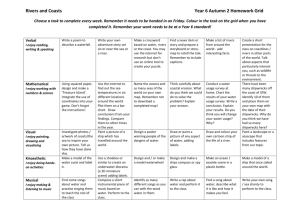HOBET V – Study Guide
advertisement
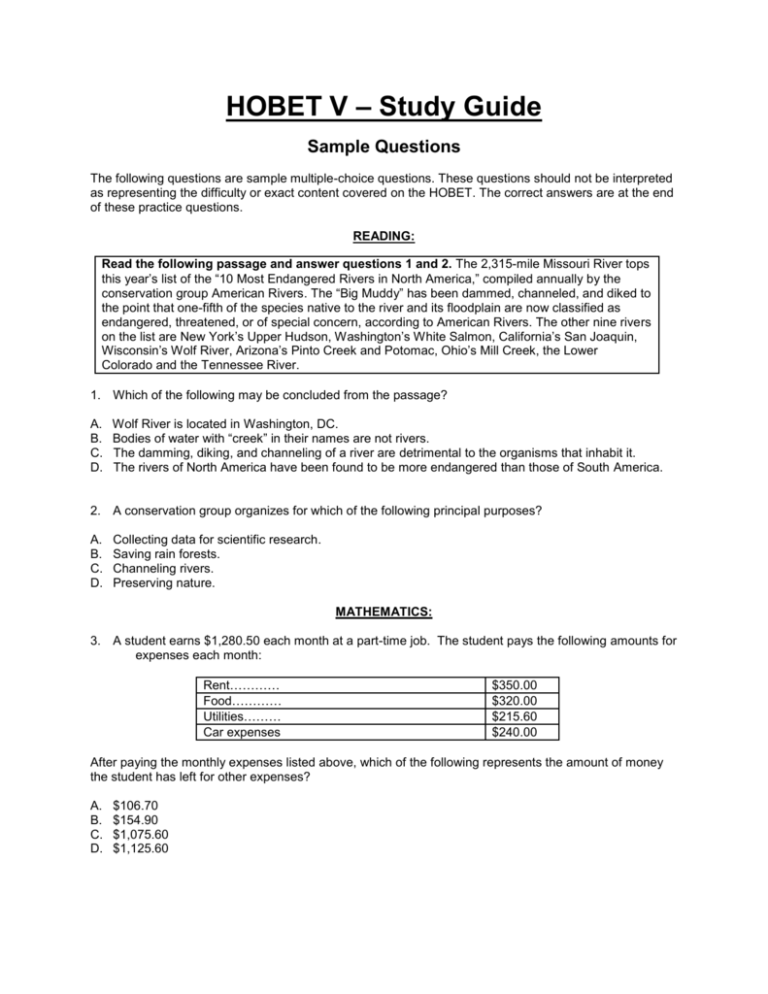
HOBET V – Study Guide Sample Questions The following questions are sample multiple-choice questions. These questions should not be interpreted as representing the difficulty or exact content covered on the HOBET. The correct answers are at the end of these practice questions. READING: Read the following passage and answer questions 1 and 2. The 2,315-mile Missouri River tops this year’s list of the “10 Most Endangered Rivers in North America,” compiled annually by the conservation group American Rivers. The “Big Muddy” has been dammed, channeled, and diked to the point that one-fifth of the species native to the river and its floodplain are now classified as endangered, threatened, or of special concern, according to American Rivers. The other nine rivers on the list are New York’s Upper Hudson, Washington’s White Salmon, California’s San Joaquin, Wisconsin’s Wolf River, Arizona’s Pinto Creek and Potomac, Ohio’s Mill Creek, the Lower Colorado and the Tennessee River. 1. Which of the following may be concluded from the passage? A. B. C. D. Wolf River is located in Washington, DC. Bodies of water with “creek” in their names are not rivers. The damming, diking, and channeling of a river are detrimental to the organisms that inhabit it. The rivers of North America have been found to be more endangered than those of South America. 2. A conservation group organizes for which of the following principal purposes? A. B. C. D. Collecting data for scientific research. Saving rain forests. Channeling rivers. Preserving nature. MATHEMATICS: 3. A student earns $1,280.50 each month at a part-time job. The student pays the following amounts for expenses each month: Rent………… Food………… Utilities……… Car expenses $350.00 $320.00 $215.60 $240.00 After paying the monthly expenses listed above, which of the following represents the amount of money the student has left for other expenses? A. B. C. D. $106.70 $154.90 $1,075.60 $1,125.60 4. Thirty percent of the students in a mathematics class received an “A.” If 18 students received an “A,” which of the following represents the number of students in the class? A. B. C. D. 18 30 54 60 SCIENCE: 5. Which of the following characteristics is a property of bases? A. B. C. D. Taste sour Dissolve metals Turn blue litmus red Liberate OH- in solution 6. The bladder is part of which of the following systems? A. B. C. D. Urinary Nervous Muscular Cardiovascular ENGLISH AND LANGUAGE USAGE: 7. The rapacity of our vile, disgusting, and despicable stepfather was not satisfied until he had taken all that we had. Which of the following words are redundant in the sentence above? A. B. C. D. rapacity, vile vile, disgusting rapacity, despicable disgusting, despicable 8. Jennifer mailed a sympathy card to the family of the dead man in a hurry. Which of the following phrases are misplaced in the sentence above? A. B. C. D. in a hurry to the family of the dead man Jennifer mailed a sympathy card SOLUTIONS TO SAMPLE QUESTIONS Sample Question Number 1 2 3 4 5 6 7 8 Answer C D B D D A B A Reading (42 items) - Paragraph and Passage Comprehension (19 items) Analyze and evaluate the use of text structure. (Study Manual 1A8) Distinguish between fact and opinion, biases, and stereotypes. (Study Manual 1A3) Identify the characteristics of different passage types. (Study Manual 1A10) Identify the intent to persuade, inform, entertain, or express feelings. (Study Manual 1A6) Identify topic, main idea, supporting details, and themes. (Study Manual 1A5) - Informational Source Comprehension (23 items) Analyze the use of headings and subheadings. (Study Manual 1B7) Demonstrate understanding of a label's ingredients and directions. (Study Manual 1B3) Identify information from a printed communication. (Study Manual 1B4) Identify information from a sample listing of items and costs. (Study Manual 1B14) Identify information from a telephone book. (Study Manual 1B13) Mathematics (30 items) - Numbers and Operations (19 items) Add (or subtract) two fractions or mixed numbers with unlike denominators. (Study Manual 4A7) Convert between Roman and Arabic numerals. (Study Manual 4A13) Solve word problems involving ratios, proportions, and rate of change. (Study Manual 4A9) Use mathematical reasoning or computational procedures to solve one- or two-step word problems with whole numbers. (Study Manual 4A8) - Algebraic Applications (4 items) Add, subtract, multiply, and divide polynomial terms. (Study Manual 4B2) - Data Interpretation (3 items) Read and interpret data from line, bar, or circle graphs. (Study Manual 4C2) - Measurement (4 items) Convert quantities from one measurement scale to another scale. (Study Manual 4D1) Science (48 items) - Human Body Science (11 items) Describe the functions of the circulatory system. (Study Manual 3A1) Describe the functions of the digestive system. (Study Manual 3A2) Describe the general anatomy and physiology of a human. (Study Manual 3A6) Identify factors that influence birth rates and fertility rates. (Study Manual 3A8) - Life Science (15 items) Describe how RNA and DNA are involved in cell replication. (Study Manual 3B10) Describe the structures and functions of nucleic acids. (Study Manual 3B8) Explain the biological classification system. (Study Manual 3B2) Identify parts of a cell and its function. (Study Manual 3B3) Identify the structure and function of cellular organelles. (Study Manual 3B4) - Earth and Physical Science (14 items) Balance and identify important chemical reactions. (Study Manual 3C2) Explain that chemical bonds result when electrons are shared or transferred between atoms. (Study Manual 3C11) Explain the difference of the atoms/molecules in liquids, gases, and solids. (Study Manual 3C13) Identify protons, neutrons, and electrons as major components of an atom. (Study Manual 3C10) Use pH scale to identify acid and base solutions. (Study Manual 3C5) - - Scientific Reasoning (8 items) Communicate and defend a scientific argument. (Study Manual 3D5) English and Language Usage (30 items) - Grammar and Word Meanings in Context (15 items) Apply subject-verb agreement rules. (Study Manual 2A2) Identify and use different parts of speech. (Study Manual 2A4) Use context clues to determine the meaning of words or phrases. (Study Manual 2A7) Use grammar for a stylistic effect and to enhance clarity. (Study Manual 2A1) - Spelling and Punctuation (9 items) Apply rules of spelling. (Study Manual 2B1) Apply the rules of ellipses, commas, semicolons, colons, hyphens, and parentheses. (Study Manual 2B4) Apply the rules of quotation marks and apostrophes. (Study Manual 2B5) - Structure (6 items) Demonstrate sentence fluency. (Study Manual 2C1) Write simple sentences. (Study Manual 2C3)

